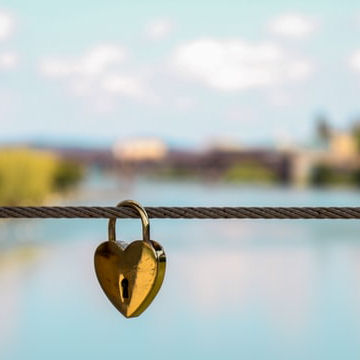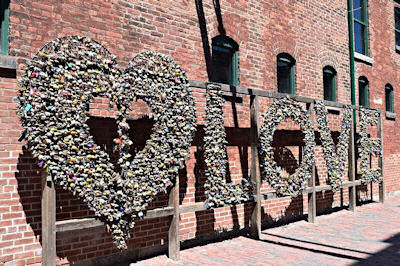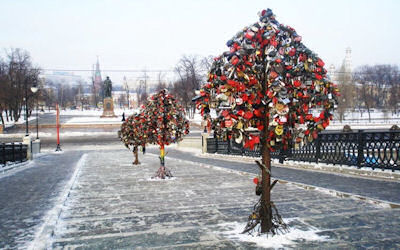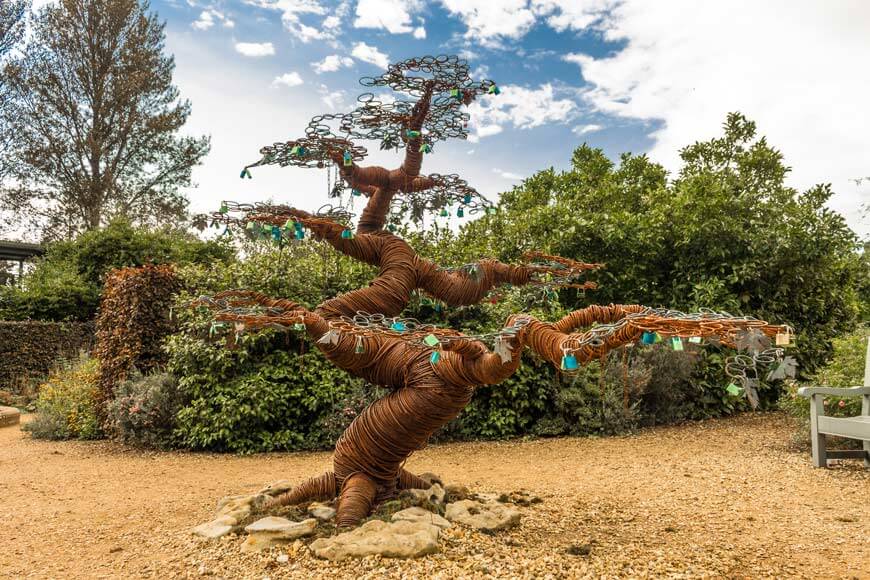Love Locks Ritual: Ancient
Relevance and Contemporary Problems
Categories: | Wedding Ceremony | Wedding Rituals |
 The
love lock unity ritual is inspired by the custom of
couples attaching a padlock to a public structure as
an expression of their love and a wish that it lasts
forever. While it therefore has ancient
relevance, it is a very new ritual, so it is
likely that it will be a totally new experience for
your guests. In the absence of established
expectations, you can make it completely your own.
Which means you have total control over the ritual
and the freedom to decide what it symbolises
for you, whether to use one lock or two, and what
you do with them as part of the ritual, or
afterwards.
The
love lock unity ritual is inspired by the custom of
couples attaching a padlock to a public structure as
an expression of their love and a wish that it lasts
forever. While it therefore has ancient
relevance, it is a very new ritual, so it is
likely that it will be a totally new experience for
your guests. In the absence of established
expectations, you can make it completely your own.
Which means you have total control over the ritual
and the freedom to decide what it symbolises
for you, whether to use one lock or two, and what
you do with them as part of the ritual, or
afterwards.What is a love lock?
The origin and spread of
the love lock custom
The first appears to be in a rather depressing World War I tale from Serbia about two lovers who are separated when the man had to go to war, leaving his fiance behind. He didn't come home. Not for the usual reason. He'd fallen in love with another woman while at the front. His heartbroken fiance died young and alone, and local girls started to attach locks to the bridge where the couple used to meet and throw the keys into the river to ensure a life of fidelity.
Fast forward to 2006 and a book by Italian author, Frederico Moccia, anId its 2007 film adaptation - I Want You - and the ritual of affixing locks to the Ponte Milvio over the River Tiber in Rome took off. And the idea and the ritual has spread rapidly, with lovers affixing locks to bridges and other structures all around the world.
Contemporary Problems
Apart from the aesthetics - cheap locks quickly become unsightly as they deterate, the two major problems are the accumulated weight of the locks and the environmental damage done by throwing the keys in the water. An accumulation of metal padlocks literally weighs tonnes, an issue when attached to bridges that have not been . designed to withstand that extra load. When thrown into water, metal keys rust and pollute the water, harm wildlife, and block drains, leading to flooding.

Cities have responded in two ways. Most have removed locks and banned the practice. Some offer alternative installations where lovers can attach their locks, such as the LOVE art installation in Toronto's Distillery District and the metal trees down the middle of the Lushkov Bridge in Moscow. But for lovers in Brisbane, no such opportunity exists in a public place.

You could send your virtual lock to a virtual love-locking site. Or you could include a love lock unity ritual in your wedding - mindfully adapted to ensure you do no damage to either the built or the natural environment.
Why love locks are
emotionally appealing
We know about the popularity of love locks and their almost universal appeal because couples have attached them to what are essential tourist attractions in romantic locations of historical importance or aesthetic appeal. While the couples may attach the locks and then leave, there is appeal and romance in knowing they have left their mark in a desirable location, to which they can return, possibly to celebrate an anniversary.
How love lock rituals echo
ancient practices
- From the Iron Age on, metal objects have been
used as offerings. Ancient Celts, Vikings, and
others deposited manufactured metal objects
(weapons, coins, in water such as rivers,
lakes, and wells). The modern practice of
attaching locks to a bridge and throwing the
keys into the water, like the widespread
practice of throwing coins into wishing wells
and fountains, continues the practice of
deposition with the expectation of receiving a
blessing or a favour. The modern ritual is
therefore a direct descendent of earlier rituals
that empowered hope.
- In mediaeval times, pilgrims would throw coins and pilgrimage badges from bridges over rivers en route to a holy shrine
- Also in mediaeval times, people would hang
votive offerings on trees surrounding the
shrines of saints, a practice also echoed in
wishing trees at ceremonies, a practice no
doubt inspired by prayer trees and clootie
trees.
Love Locks Unity Ritual
basics
Environmentally friendly
ways to include love locks in your wedding
- Locking the lock, either to some fixture, or
to another lock
- Doing something with the key(s)/code
The lock(s)
Where you are holding your ceremony will have a
significant impact on what you can do with the
locks. .Unless the venue has an installation for the
purpose, you will be limited to linking two locks to
one another or attaching the lock to something that
is portable and can be removed at the end of the
ceremony. This is where a short length of chain with
large links will be a good choice. As would a
sculptural item of some sort.
If you are marrying in your own backyard, you are far less limited. You could attach your lock(s) to your fence or balcony/deck railing. You could commission a purpose created metal sculpture, or choose an perforated aluminium screen, for example.
The key(s)
What you do with your key(s) is limited only by your
imagination! Some ideas: - Bury them in a meaningful place, such as the
garden of your home, or, to make sure you can't
retrieve them, have someone else bury them
without telling you where
- Melt them in a fire. You can then keep and display the now-useless lump of metal
- Have them gold or silver-plated and turned into jewelry - pendant, tie-pin, charm attached to a bracelet are all options
- Frame the keys in a shadow frame together with other artefacts from your wedding, or on their own.
- Present the keys to your legal witnesses for safekeeping
- Mail them in an unaddressed but adequately stamped envelope with no return address so they end up in the Post Office Lost Property Office with no possibility of being retrieved.
- Emulate the method adopted by the staff of the
Namsan Seoul Tower and put them into a sealed
"love box" or you could add a fun element by
post them through the slot in a sealed money
box.
On the practical side
- Make the decisions about what the ritual
symbolises for you, how you want it to play out,
and what you want to attach the lock or locks to
before you buy your lock(s).
- Make sure that the shackle of the lock you choose is neither too thick nor too short to be used the way you envisage
- While the body of your lock is unlikely to be made of steel hardened to the point where it will be impossible to engrave, it is best to decide whether you want to inscribe, engrave, or paint names and/or the date on it and choose a lock that will accommodate that method
- Buy as big a lock as you can source at an
affordable price. Very small locks are too
easily obscured by your hands during the ritual,
which makes for disappointing photographs.
As with all rituals, I purpose create both words and actions to suit your vision. Thanks for reading!
se hostAperthayou 0 Things
